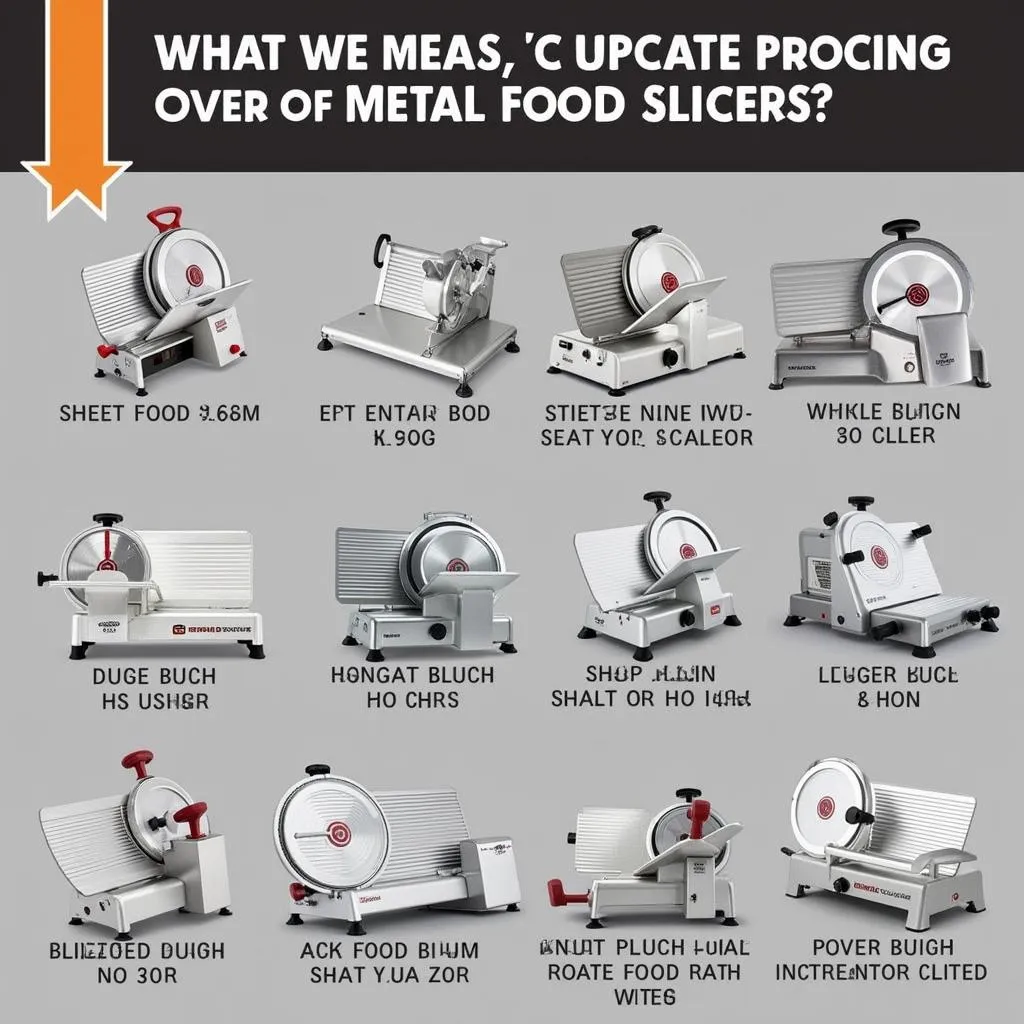Metal Food Slicers have become a kitchen staple, prized for their durability, precision, and versatility. Whether you’re a seasoned chef or a passionate home cook, a metal food slicer can elevate your culinary game by making quick work of slicing everything from delicate vegetables to savory meats. But with so many models available, choosing the right one can feel overwhelming. This comprehensive guide delves into the world of metal food slicers, equipping you with the knowledge to make an informed decision.
 Choosing the Right Metal Food Slicer
Choosing the Right Metal Food Slicer
Why Choose a Metal Food Slicer?
Investing in a metal food slicer offers several advantages over their plastic counterparts or manual knives:
- Durability: Crafted from high-quality metals like stainless steel or aluminum, these slicers are built to last, resisting rust, corrosion, and warping.
- Precision: Achieve consistent, paper-thin slices with adjustable thickness settings, ensuring even cooking and professional-looking presentations.
- Versatility: From slicing meats and cheeses for charcuterie boards to prepping vegetables for salads or stir-fries, these slicers handle a wide range of ingredients.
- Time-Saving: Significantly reduce your food prep time, especially when working with large quantities.
- Safety: Equipped with safety features like blade guards and food carriages, these slicers minimize the risk of accidents.
Key Features to Consider
Before diving into the specifics of metal food slicers, let’s explore the crucial features that influence their performance and suitability for your needs.
Blade Size and Type
The blade is the heart of any slicer. Metal food slicers typically feature blades ranging from 7 to 12 inches in diameter. Larger blades are ideal for handling larger cuts of meat and bread, while smaller blades offer greater maneuverability for slicing delicate items.
- Serrated Blades: Perfect for slicing bread, bagels, and meats with a crust.
- Smooth Blades: Ideal for slicing delicate items like tomatoes, cucumbers, and boneless meats.
- Specialty Blades: Some models offer specialized blades for specific tasks, such as slicing cheese or making french fries.
 Types of Food Slicer Blades
Types of Food Slicer Blades
Power and Motor
Most metal food slicers are electrically powered, offering convenience and efficiency. The motor’s power determines its ability to slice through tough ingredients.
- Wattage: Look for models with a wattage of 100 to 200 for home use. Higher wattage indicates a more powerful motor.
- Direct Drive vs. Belt Drive: Direct-drive motors offer more power but can be louder. Belt-drive motors are quieter but may sacrifice some power.
Thickness Settings
The ability to adjust slicing thickness is crucial for versatility. Most slicers offer adjustable thickness settings, typically ranging from paper-thin to about 3/4 of an inch.
Safety Features
Safety should be a top priority when choosing a metal food slicer. Look for features such as:
- Blade Guard: A protective cover that shields the blade when not in use.
- Food Carriage: Holds the food securely in place and guides it towards the blade, preventing accidental contact.
- Safety Switch: Prevents the slicer from operating unless the blade is properly engaged.
Types of Metal Food Slicers
There are two main types of metal food slicers:
1. Manual Food Slicers
- Pros: More affordable, compact, and don’t require electricity.
- Cons: Require more effort to operate, especially for larger or tougher items.
- Best for: Occasional use, small kitchens, slicing small quantities of food.
2. Electric Food Slicers
- Pros: Powerful, efficient, can handle a wider variety of ingredients.
- Cons: More expensive, bulkier, require an electrical outlet.
- Best for: Frequent use, larger families, slicing a variety of foods, including meats and cheeses.
Cleaning and Maintenance
Keeping your metal food slicer clean is essential for hygiene and longevity.
- Always unplug the slicer before cleaning.
- Disassemble removable parts, such as the blade, food carriage, and food pusher, and wash them with warm, soapy water.
- Wipe down the base and other non-removable parts with a damp cloth.
- Dry all parts thoroughly before reassembling.
- Lubricate the blade with food-grade mineral oil after cleaning and drying.
 Cleaning a Metal Food Slicer
Cleaning a Metal Food Slicer
Conclusion
A metal food slicer can be a game-changer in the kitchen, simplifying food preparation and opening up a world of culinary possibilities. By understanding the key features, types, and maintenance requirements, you can choose the slicer that perfectly suits your needs and elevates your cooking to the next level.
FAQ
1. Can I sharpen the blade on my metal food slicer?
Yes, most metal food slicer blades can be sharpened. Refer to your slicer’s manual for specific instructions.
2. Can I slice frozen food with a metal food slicer?
No, it’s not recommended to slice frozen food with a metal food slicer as it can damage the blade and motor.
3. How do I store my metal food slicer?
Store your slicer in a dry, cool place, preferably in its original packaging or with the blade guard in place.
Need Help? Contact Us!
For any questions or assistance in selecting the perfect metal food slicer for you, our team is here to help!
Phone: 02437655121
Email: minacones@gmail.com
Address: 3PGH+8R9, ĐT70A, thôn Trung, Bắc Từ Liêm, Hà Nội, Việt Nam
We have a dedicated customer support team available 24/7.